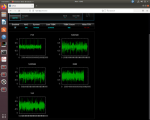bunkeyslocksmith
Member
I have been semi successful setting up and running op25 on pi and an ubuntu laptop . My latest problem that I just cant figure out is that in my trunk.tsv file I have entered the frequency of 139.245 which is a near by CC that works well. I never seem to get my TGID list .tsv file to work right, so for now have resorted to using a simplified command line as follows:
./rx.py --args 'rtl' --gains 'lna:49' -f 139.245e6 -t -q 0 -S 1000000 -D cqpsk -2 -V -U 2> stderr.2
For a while it seemed to work really well but after messing with so many things, re-installs, other problems - etc (not to mention being a NOOB - lol) it now has a problem every time I fresh install, set it up and run it (using above command line in the proper directory chain) -the TGIDs show nothing and no audio is present. Looking at the bottom line of the program when it starts running (erroneously) it is clear that I am not on the selected frequency of the control channel as per trunk tsv file or my command line mentioned already. The wrong frequency appears as 000.139 mhz
The make-do solution I have been using is to hit 'F' and then manually change the wrong frequency of 000.139 to what it should be (139.245). After that everything kicks in like it should - the TGIDs numbers increase and good steady, reliable audio is started immediately. I guess its alright the way it is, but I hope to make a simple headless autoboot Pi OP25 and that manual entry of the frequency isn't going to be much fun every time I turn it on to listen.
I cant for the life of me figure out why it is behaving this way. Perhaps I am just missing something. Anybody else encounter this problem and manage to fix it? Any help would be appreciate. Thanks.
Kevin.
./rx.py --args 'rtl' --gains 'lna:49' -f 139.245e6 -t -q 0 -S 1000000 -D cqpsk -2 -V -U 2> stderr.2
For a while it seemed to work really well but after messing with so many things, re-installs, other problems - etc (not to mention being a NOOB - lol) it now has a problem every time I fresh install, set it up and run it (using above command line in the proper directory chain) -the TGIDs show nothing and no audio is present. Looking at the bottom line of the program when it starts running (erroneously) it is clear that I am not on the selected frequency of the control channel as per trunk tsv file or my command line mentioned already. The wrong frequency appears as 000.139 mhz
The make-do solution I have been using is to hit 'F' and then manually change the wrong frequency of 000.139 to what it should be (139.245). After that everything kicks in like it should - the TGIDs numbers increase and good steady, reliable audio is started immediately. I guess its alright the way it is, but I hope to make a simple headless autoboot Pi OP25 and that manual entry of the frequency isn't going to be much fun every time I turn it on to listen.
I cant for the life of me figure out why it is behaving this way. Perhaps I am just missing something. Anybody else encounter this problem and manage to fix it? Any help would be appreciate. Thanks.
Kevin.


